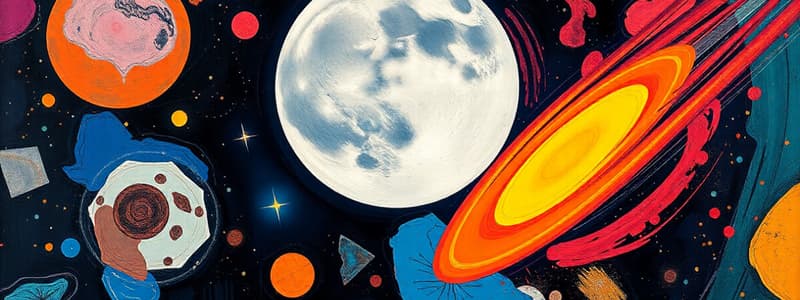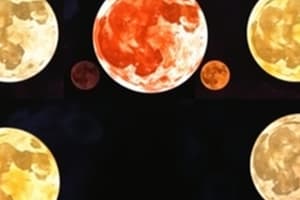Podcast
Questions and Answers
The moon takes exactly 29.5 days to orbit the Earth completely.
The moon takes exactly 29.5 days to orbit the Earth completely.
False (B)
A synchronous orbit means that the same side of the moon always faces the Earth.
A synchronous orbit means that the same side of the moon always faces the Earth.
True (A)
C-type asteroids are known for their bright appearance due to nickel-iron composition.
C-type asteroids are known for their bright appearance due to nickel-iron composition.
False (B)
The moon's mass is about 12% of the Earth's mass.
The moon's mass is about 12% of the Earth's mass.
M-type asteroids can have volcanic lava on their surface.
M-type asteroids can have volcanic lava on their surface.
The lunar cycle includes eight different phases of the moon.
The lunar cycle includes eight different phases of the moon.
Meteors are commonly visible as they enter the Earth’s atmosphere and burn up.
Meteors are commonly visible as they enter the Earth’s atmosphere and burn up.
S-type asteroids are primarily composed of clay and silicate rocks.
S-type asteroids are primarily composed of clay and silicate rocks.
A meteor becomes a meteorite when it completely disintegrates in the atmosphere.
A meteor becomes a meteorite when it completely disintegrates in the atmosphere.
Comets with orbits longer than 200 years are categorized as long-period comets.
Comets with orbits longer than 200 years are categorized as long-period comets.
Short-period comets originate from the Oort Cloud.
Short-period comets originate from the Oort Cloud.
Thermal energy is related to the speed at which atoms and molecules vibrate.
Thermal energy is related to the speed at which atoms and molecules vibrate.
Conduction transfers heat using electromagnetic waves.
Conduction transfers heat using electromagnetic waves.
Radiation does not require a medium to transfer heat.
Radiation does not require a medium to transfer heat.
Sedimentary rocks are formed by layers of sediment being squeezed together.
Sedimentary rocks are formed by layers of sediment being squeezed together.
Flashcards
Moon
Moon
Earth's only natural satellite that orbits it.
Synchronous orbit
Synchronous orbit
When an object rotates on its axis at the same rate it orbits another object.
Lunar cycle
Lunar cycle
The period of about 29.5 days for the moon to complete its phases.
Moon phases
Moon phases
Signup and view all the flashcards
Asteroids
Asteroids
Signup and view all the flashcards
Meteoroid
Meteoroid
Signup and view all the flashcards
Meteor
Meteor
Signup and view all the flashcards
Asteroid types
Asteroid types
Signup and view all the flashcards
Meteorite
Meteorite
Signup and view all the flashcards
Comet
Comet
Signup and view all the flashcards
Long-period comets
Long-period comets
Signup and view all the flashcards
Short-period comets
Short-period comets
Signup and view all the flashcards
Geological layers
Geological layers
Signup and view all the flashcards
Radioactive dating
Radioactive dating
Signup and view all the flashcards
Heat transfer methods
Heat transfer methods
Signup and view all the flashcards
Study Notes
Moon
- Earth's only natural satellite
- Orbits Earth
- Younger than Earth, formed about 4.6 billion years ago
- Formed from debris from a collision between Earth and a Mars-sized object
- Does not produce its own light; reflects sunlight
- Approximately 1,080 miles in circumference
- Possesses 1.2% of Earth's mass
- Circular orbit, 27.32 days to orbit Earth
- Synchronous orbit – always shows the same side to Earth
- Different phases due to sunlight reflection
- Lunar cycle of 29.5 days
- 8 phases based on visible surface area
Asteroids, Meteors, and Comets
- Asteroids: Rocky space debris, ranging from 1 km to hundreds of km
- Located in the asteroid belt between Mars and Jupiter
- 3 main types:
- C-type (chondrite): clay and silicate rocks, dark color
- S-type (stony): nickel-iron and silicate, somewhat bright
- M-type (metallic): nickel-iron, some with volcanic lava, bright
- Meteors: Rocks or debris from space burning up in Earth's atmosphere (shooting stars)
- Meteoroid: meteor in space
- Meteorite: meteor reaching Earth's surface
- Comets: Icy objects with large orbits around the sun
- Release gases when close to the sun, forming a bright head and tail
- Originate from the Oort Cloud or Kuiper Belt
- 2 categories:
- Long-period comets: orbits over 200 years (Oort Cloud)
- Short-period comets: orbits under 200 years (Kuiper Belt)
Determining Earth's Age
- Geological layers provide relative age information: deeper layers are older
- Radioactive dating: estimates age based on radioactive isotopes' decay rate
- Half-life: time taken for half of a radioactive element to decay
Heat Transfer
- Heat (thermal energy) measures atomic/molecular vibration speed
- Measured by thermometers
- Heat transfer occurs between objects
- Conduction: Heat transfer through direct contact
- Convection: Heat transfer through fluid movement (e.g., hot air rising)
- Radiation: Heat transfer through electromagnetic waves; no medium needed
Studying That Suits You
Use AI to generate personalized quizzes and flashcards to suit your learning preferences.




